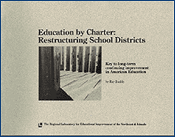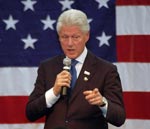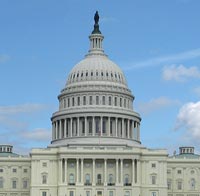Web Resource • September 2010
Asking “Where did it start?” is like asking where a river starts. You have to go upstream, where you probably will find no single source, but several little streams flowing together. Albert Shanker and Ray Budde had the ‘charter’ idea early. Minnesota got it into law; seeing ‘charter’ not as a kind of school but as a platform for developing different schools.
It was mostly word of mouth. No master plan; no national ‘project’. Not many education-policy groups supportive; the academic community inattentive. No foundation grants and little media coverage at the start (though both came quickly as the laws appeared.) Efforts in the states were strikingly bipartisan; enacting what ‘realists’ said couldn’t possibly be done. Importantly, too: Congressional legislation in 1994 deferred to state lawmaking.
Use our timeline to learn more about the progress of the chartering idea. Adjust the level of detail shown on the timeline by dragging the slider below.
| Headings Only | More Detail | Full Story |
Ray Budde writes “Education by Charter” paper.
Ray Budde, an educator from Massachusetts, presents Education By Charter as an idea for a restricting of school districts, to the Society for General Systems Research. Response? Zero.
The two reports A Nation at Risk and A Nation Prepared stimulate cultural shift.

Two reports, A Nation at Risk (National Commission on Excellence in Education 1983) and A Nation Prepared: Teachers for the 21st Century (Carnegie Forum on Education and The Economy 1986), stimulate a cultural shift. ‘Restructuring’ seems more possible.
Minnesota enacts “inter-district open enrollment” and other choice legislation.
Minnesota education begins to unbundle in 1985 as its Legislature enacts the Post-Secondary Enrollment Option (allowing juniors and seniors to finish high school in college), a proposal by (Republican) House majority leader Connie Levi. In 1986-1987, the Legislature enacts inter-district open enrollment, an idea proposed by Governor Rudy Perpich. Quickly, though, it’s clear that choice among districts has limited effects. The focus shifts to have more schools for students and families to choose among. The question becomes: How create schools new? And: Who creates them?
Also in the mid-1980s Jack Coons of University of California-Berkeley visits Minnesota to deliver the commencement address at the University of St. Thomas. He meets with folks interested in public schooling, championing ideas about family choice in education, which many find difficult to tolerate. Between 1971 and 1999, Coons and his colleagues, including Stephen D. Sugarman, write a number of publications explaining and advocating school choice mechanisms that they hope will assure genuine choice to families who are financially disadvantaged. Mechanisms include four kinds of schools: traditional public schools, public ‘scholarship schools’ that would be outside of traditional district control (this concept pre-dated Budde’s term ‘charter’), private schools that would accept vouchers (and in exchange would not be allowed to raise outside money), and private schools that would be outside the system and could fund themselves however they wanted with no limits.
Citizens League proposes “cooperatively managed schools”.
Citizens League, a policy design and advocacy organization in Minnesota directed by Curtis Johnson (today partner at Education|Evolving), proposes “cooperatively managed schools” that would offer larger professional roles for teachers.
Budde publication from 1974 republished and distributed widely.
Northeast Regional Lab publishes a new version of Budde’s 1974 Education by Charter. Budde distributes it widely. He waits.
Albert Shanker proposes autonomous schools led by teachers.
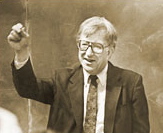
Albert Shanker, then President of the 907,000 member American Federation of Teachers, floats the idea of teachers setting up new autonomous schools (in existing school buildings) to the National Press Club. The best name for these schools, he said, came from Ray Budde: charter schools.
Budde and Shanker ideas resonate with Budde and Citizens League.
Budde’s wife reads Shanker’s column describing his Press Club appearance. “Hey, Ray. You made the New York Times!” A Citizens League study committee that had been examining the Minnesota school structure ‘situation’ since February 1988 considers Shanker’s proposal and Budde’s ideas.
Citizens League study committee evolves the ideas.
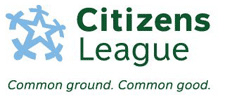
The Citizens League study committee, chaired by CEO of Cray Research John Rollwagen and with significant leadership from Ted Kolderie (now co-founder of Education|Evolving), modifies the ideas of Budde and Shanker. The group envisions ‘chartered schools’ made possible via state policy and with schools being approved by the state or by universities as well as by a local board of education. These new schools could be set up outside an existing school building.
Minnesota policymakers start thinking about state legislation.
Virginia Greenman of The Minneapolis Foundation, aware of the Citizens League work, flies Shanker to Minnesota for the foundation’s Itasca Seminar at Gull Lake, devoted that year to K-12 education. Sy Fliegel, Deputy Superintendent in an East Harlem school district, describes to attendees the new and charter-like schools created there. After Shanker leaves Gull Lake several attendees begin thinking about how to realize the Citizens League version of the idea in Minnesota. The group includes Joe Nathan, a Citizens League member who had spoken with the study committee, and two legislators: DFL Senator Ember Reichgott and Representative Ken Nelson, who start thinking about state legislation.
Citizens League publishes landmark chartered school proposal.
The Citizens League publishes Chartered Schools = Choices for Educators + Quality for All Students.
Joe Loftus almost simultaneously proposes “charter schools” in Chicago.
In Chicago, Joe Loftus almost simultaneously comes up with the idea in his work for the Urban Child Welfare Project of the Center for Research, Planning and Advocacy. He publishes Charter Schools: A Potential Solution to the Riddle of School Reform. Ideas Loftus advanced in the paper come into chartering much later, but in Chicago at the time his idea loses out to the idea of parent-run schools.
Legislators attempt to get “chartering” into law in Minnesota.
Senator Reichgott gets a charter provision into the Minnesota Senate education omnibus bill both years. The House does not accept it. But as the conference committee breaks up in 1990, DFL Representative Becky Kelso tells Reichgott: “If you’d like to try that charter idea again next year, I’d like to help you.” In fall 1990 Governor Perpich’s Commissioner of Education, Tom Nelson, chairs a task force that creates an improved bill. The Citizens League is active in all of this legislative effort, in particular Peter Vanderpoel. There was also some support from teachers.
Minnesota Legislature passes first version of chartered school bill.
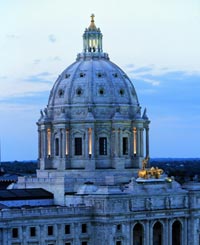
Representative Kelso and Nelson gets a compromised version of the bill through the House (with a cap on the number of schools and with districts as the sole authorizers; both since dropped from Minnesota law). The Senate accepts the conditions. Governor Arne Carlson signs it into law as part of the omnibus bill.
Joe Nathan, by then head of the Center for School Change at the University of Minnesota’s Humphrey Institute, takes the lead in assembling teachers and others to use the enabling legislation to start schools. Gradually proposals begin to appear; schools begin to appear.
The ink on the new law was barely dry when U.S. Senator from Minnesota Dave Durenberger (R) and Senator Joseph Lieberman (D-CT) introduce the federal Public School Redefinition Act, creating a federal start-up grant program for chartered schools. It does not pass. The authors remain committed to the principal goals: build awareness of the charter idea nationally, encourage states to pass chartered school laws, and address the absence of planning and start-up funding for schools.
California Legislature passes chartered school bill in California; Bill Clinton is supportive of chartered schools in his campaign.
Eric Premack, a Minneapolis native and former Citizens League intern, spreads the idea in California and arranges meetings between Ted Kolderie and key actors in the state. California enacts a chartering program, in somewhat different form. Senator Gary Hart authors the bill and gets it through on the last evening of the session.
Will Marshall at the Democratic Leadership Council spots the potential of public-school choice and chartering for the DLC agenda. He makes it central in the policy-book they do for Bill Clinton. Taking office in 1993, Clinton is a supporter. Secretary of Education Richard Riley and his Special Assistant Jon Schnur work to expand the concept.
U.S. Senators Durenberrger and Lieberman reintroduce the Public School Redefinition Act. Representatives Dave McCurdy (D-OK) and Tom Petri (R-WI) introduce companion legislation in the U.S. House. Again, it is not enacted.
Six additional states enact chartering legislation.
Six states act. There is bipartisan leadership. Barbara O’Brien at the Colorado Childrens Campaign is key in Colorado. Representative Peggy Kerns (D) and Senator Bill Owens (R) become authors. Governor Roy Romer (D) makes the bill a ‘must’. In Wisconsin, Senn Brown is important, at the Wisconsin Association of School Boards. In Massachusetts, Mark Roosevelt, chair of the Assembly Education Committee and soon to be Democratic nominee for governor, authors. These Acts introduce more variations on the original idea. Ted Kolderie, Joe Nathan and others are on the road to support these efforts.
Clinton includes chartered school grant program in ESEA reauthorization.
President Clinton includes the charter grant program first proposed in 1991 by Senators Durenberger and Lieberman in his legislation reauthorizing the federal Elementary and Secondary Education Act. The U.S. Congress adopts the legislation. The federal grant program goes from $6 million to over $200 million. In House/Senate conference committee deliberations, a bipartisan alliance between Senator Durenberger, Senator Ted Kennedy (D-MA), and the Clinton Administration (including Secretary Riley and his special assistant Jon Schnur) succeeds in overcoming the House position that only districts should be allowed to authorize chartered schools. The final bill leaves this critical question to be answered by each state in their chartering laws.
The National Education Association launches a task force to examine chartering, which later results in an effort to start schools under the charter laws in several states.
Many more states enact chartering legislation.
Through the 1990s chartering spreads, essentially as a “state capitol policy initiative”. Senator Jack Ewing (R) and Assemblyman Joe Doria (D) in New Jersey. Wib Gulley (D) in North Carolina. Governor John Engler (R) in Michigan. Congressman Tom Ridge (R) picks up the idea while still in Congress; his assistant Charles Zogby. Representative Joe Tedder gets his bill through as a freshman Democrat in Florida. Senator Tom Patterson (R) and Representative Lisa Keegan (R) in Arizona. Wily old hands like Senator Cooper Snyder (R) and Representative Mike Fox (R) in Ohio. On and on. Congress does a chartering law for the District of Columbia, thanks partly to a Wisconsin congressman and to determined effort by the business community through the Federal City Council. In state after state a few local citizens, too, who just don’t quit.
Jeanne Allen and the Center for Education Reform keep track of the laws. Jon Schroeder leads the creation of a new ‘infrastructure’ called the Charter Friends National Network.
Budde pushes again for decentralization inside of districts.
Budde publishes The Evolution of the Charter Concept, continuing to hope that the decentralized model advanced in the chartering laws would come to be used by districts, too. In a personal note to Ted Kolderie in 1992 he had written, “there has to be a formal, legal change that would … remove power from most central office positions and flow funds directly to schools” and that these changes would have to be “grounded in state law.”
Minnesota receives innovation award for chartering law.
Minnesota receives the Innovation in American Government Award from the Kennedy School of Government at Harvard University for the chartering law.
Also, George W. Bush prominently includes chartering as part of his education platform and is elected President.
Barack Obama and John McCain include chartered schools in their presidential campaigns.
Senators Barack Obama (D) and John McCain (R) prominently include charter schools as part of their education platforms in their campaigns for US President.
President Obama and Secretary Duncan seek to expand chartering in states.
With more than $4 billion in federal aid, President Obama and Education Secretary Arne Duncan pressure states to ease limits on chartered schools.
